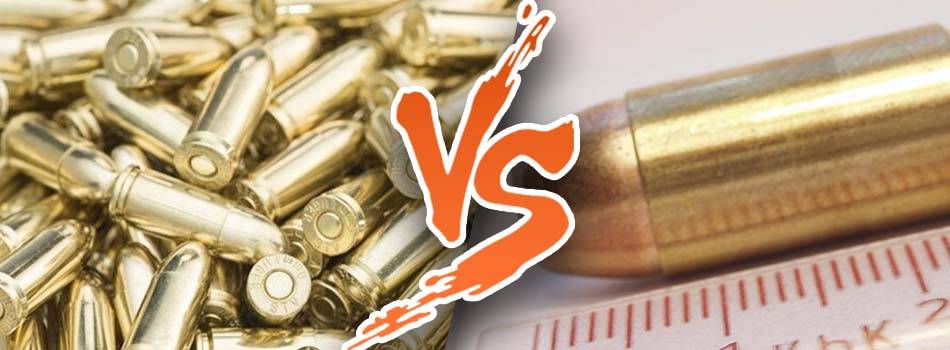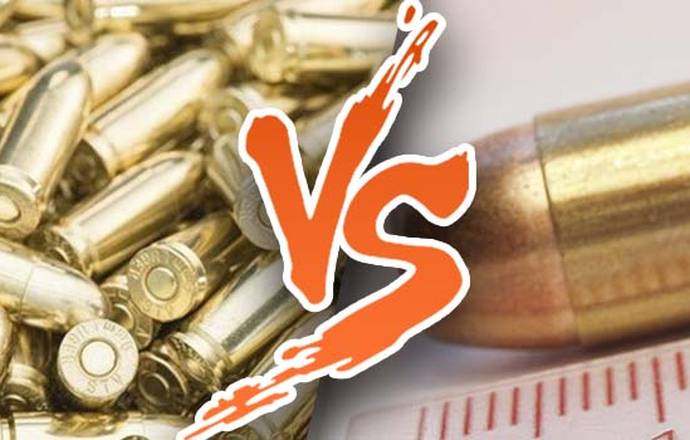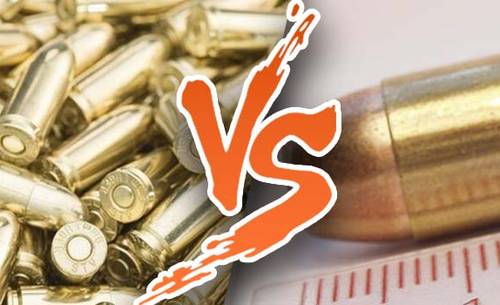


The debate between the 9mm vs .40 S&W calibers is one that has divided several of my shooting range friends, a discussion that is also reflected across the country.
Developed in different eras to meet distinct ballistic needs, each has carved its niche in the realms of law enforcement, military operations, and civilian shooting. The 9mm Luger, introduced in the early 20th century, quickly became a staple for armies and police forces worldwide, celebrated for its balance of power, capacity, and ease of handling.
In contrast, the .40 S&W emerged in the late 20th century, answering the call for a round that bridged the gap between the 9mm's efficiency and the .45 ACP's stopping power.
To try and settle this deep debate, let’s dive into the origins, development, and practical applications of these calibers.
9MM VS .40 S&W: HISTORICAL CONTEXT
9MM LUGER
The 9mm Luger, or 9x19mm Parabellum, was designed by Georg Luger in 1902, quickly gaining favor for its relatively high velocity, manageable recoil, and ability to carry more rounds than its contemporaries.
Its adoption by the German Army in 1908 marked the beginning of a legacy that would see the 9mm become one of the most widely used handgun calibers in the world. Its popularity was not just confined to military use; law enforcement agencies and civilian shooters alike praised the 9mm for its versatility across various shooting disciplines.
The caliber's widespread acceptance can be attributed to its reliable performance, which has been enhanced over the years with advances in bullet design and propellant technology.
.40 S&W
Responding to the demands for a more potent round following the 1986 FBI Miami shootout, the .40 S&W was developed by Smith & Wesson and Winchester in 1990.
It was designed to replicate the ballistic performance of the FBI's reduced-velocity 10mm Auto load without the hefty recoil. This new caliber offered law enforcement a middle ground, combining the manageable recoil and higher magazine capacity of the 9mm with closer stopping power to the .45 ACP.
The .40 S&W quickly caught on with police departments across the United States, with many switching from their 9mm and .45 ACP pistols. Its adoption was not limited to law enforcement; the .40 S&W also found a substantial following among civilian shooters who appreciated the caliber's balance of power and capacity.
9MM VS .40 S&W: BALLISTICS
When dissecting the ballistic characteristics of the 9mm and .40 S&W, the discourse often centers on velocity, energy, and impact force.
- The 9mm, with its lighter projectiles, typically boasts higher velocities. This speed translates to a flatter trajectory over distance, making it a preferred choice for situations requiring precision
- In contrast, the .40 S&W fires larger, heavier bullets, which, despite a slower velocity, deliver more energy on target—a crucial factor for stopping power, a metric where the .40 S&W often surpasses the 9mm, especially in short-range engagements where ballistic performance is paramount
The practical implications of these differences are multifaceted.
The 9mm's higher velocity and lower recoil make it easier for shooters to achieve rapid, accurate follow-up shots, a vital attribute in both competitive shooting and defensive scenarios. Conversely, the .40 S&W's greater energy and impact force enhance its ability to neutralize threats more efficiently, albeit with increased recoil.
This recoil can impact shooter proficiency, particularly among those with less experience or lower hand strength, potentially affecting accuracy in high-stress situations.
40 S&W VS 9MM: PRACTICAL APPLICATIONS
The evolution of law enforcement's caliber preference is a tale of changing needs and technological advancements. Initially, many agencies adopted the .40 S&W in the quest for a round that offered a compromise between the 9 mm capacity and the .45 ACP's stopping power.
However, the last decade has seen a notable shift back to the 9mm by many departments. This reversal is largely attributed to significant improvements in 9mm ammunition technology, offering enhanced stopping power that rivals or exceeds that of the .40 S&W without sacrificing magazine capacity or controllability.
WHY THE SHIFT?
This decision-making process is influenced by several critical criteria, including:
- Magazine capacity—inherently higher in 9mm firearms due to the caliber's smaller size, allowing for more rounds to be carried
- Stopping power, once a decisive advantage for the .40 S&W, has become less differentiated as 9mm technology has advanced
- Shooter proficiency, particularly in high-stress scenarios, has been shown to benefit from the 9mm's reduced recoil, enabling more accurate and faster follow-up shots.
These factors, combined with the lower cost and wider availability of 9mm ammunition, have contributed to its resurgence in popularity among law enforcement agencies and civilian shooters alike.
9MM VS .40 S&W: HANDLING, RECOIL, CAPACITY
The handling and recoil of a firearm can significantly affect a shooter's accuracy and comfort, particularly under stress or during extended shooting sessions.
9MM RECOIL
The 9mm, known for its manageable recoil, allows shooters to maintain control and deliver accurate follow-up shots quickly. This feature makes it an appealing choice for a wide range of shooters, including those with less hand strength or limited shooting experience.
RECOIL OF THE .40 S&W
The .40 S&W, in contrast, is characterized by a sharper recoil, which can challenge shooters to maintain the same level of control and precision. While some shooters adapt to the .40 S&W's recoil with training, others may find it less comfortable for prolonged use.
MAGAZINE CAPACITY
Magazine capacity is another critical consideration, with the 9mm generally offering a higher capacity than the .40 S&W in firearms of the same size. This difference means that shooters can carry more rounds in a 9mm magazine, providing a tactical advantage in situations where reloading may not be feasible.
The higher capacity of the 9mm is particularly valued in competitive shooting and self-defense scenarios, where the ability to engage multiple targets without reloading can be crucial.
9MM VS .40 S&W: PREFERENCES AND DEVELOPMENTS
The landscape of ammunition technology is continually evolving, with advancements in bullet design and propellants enhancing the performance of both the 9mm and .40 S&W.
Modern 9mm ammunition, for example, offers improved penetration and expansion, narrowing the performance gap with the .40 S&W in terms of stopping power. Similarly, .40 S&W ammunition has seen refinements that mitigate its recoil without sacrificing its inherent energy advantage.
INTENDED USE GOES A LONG WAY
Personal preference plays a significant role in choosing between these two calibers.
- Some shooters are drawn to the 9mm for its capacity, reduced recoil, and the economic benefits of lower ammunition costs.
- Others prefer the .40 S&W for its perceived stopping power and the confidence it instills in handling more significant threats.
- Training and intended use are also pivotal, as the choice between calibers should align with the shooter's comfort, proficiency, and the scenarios in which the firearm will be used.
Whether for law enforcement duty, home defense, or competitive shooting, the decision between the 9mm and .40 S&W ultimately hinges on balancing these factors to meet the shooter's needs and preferences.
THE CHOICE BETWEEN 9MM VS .40 S&W
The debate between 9mm and .40 S&W is not just about ballistic performance—it's a consideration of handling, recoil, capacity, and how these factors align with individual needs and preferences.
- The 9mm offers higher magazine capacity, lower recoil, and a wide array of ammunition options that have significantly improved in terms of stopping power due to modern advancements.
- Conversely, the .40 S&W provides a middle ground with its notable stopping power and manageable capacity despite its sharper recoil.
Choosing between these calibers should be a thoughtful process, reflecting on personal comfort with recoil, the intended use of the firearm (be it for self-defense, duty, or competitive shooting), and the practicality of magazine capacity in envisioned scenarios.
Each caliber has its advocates and detractors, but the ultimate decision lies in which caliber meets your specific requirements, providing confidence and reliability when it matters most.
MATCHING CALIBER WITH CRAFT
Personal preferences mean a lot, whether you’re at the range, at home, on the job, or hunting. Having the right equipment means you can use your weapon with greater ease and confidence when you need it.
Craft Holsters has a wide variety of options that are specifically designed for the most popular models on the market today—each with a variety of carrying options available, too.
Check us out to see the choices that can turn your carry option up to the next level.
